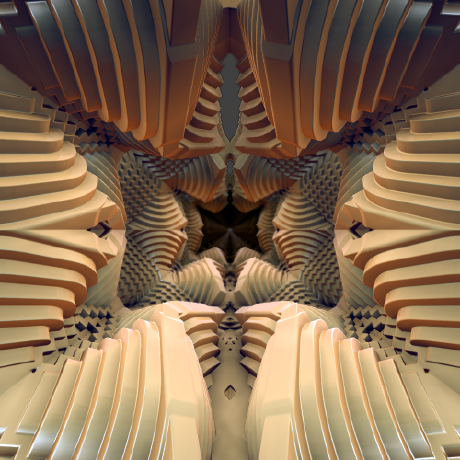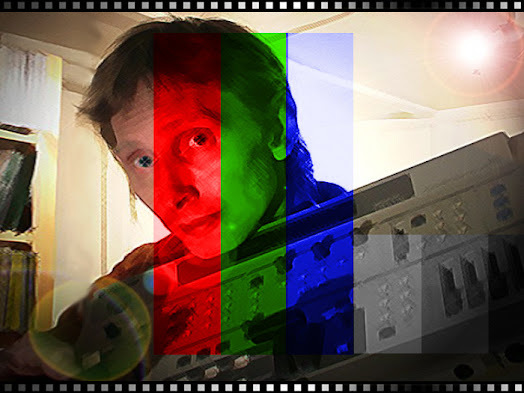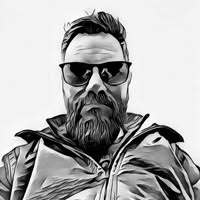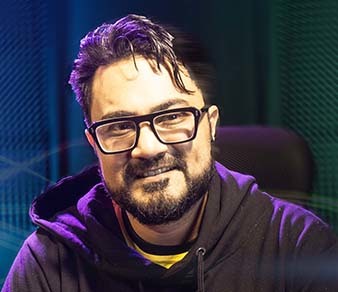VC | EP17 - The Hive Master/Bjorn Jelinek - The Portal Opening, Stargate Engineer
VC | EP18 -Prizma/Diego Mauricio - The Ever Evolving Capturing and Authentic Creative
VC | EP19 - Psybernautics/Alex T-man - GLSL my timbers, Walking the real-time & Generative Plank
Podcasts
VC | EP17 - The Hive Master/Bjorn Jelinek - The Portal Opening, Stargate Engineer
VC | EP18 -Prizma/Diego Mauricio - The Ever Evolving Capturing and Authentic Creative
VC | EP18 -Prizma/Diego Mauricio - The Ever Evolving Capturing and Authentic Creative
The Visual Cast










Discussion (3)
VC | EP19 - Psybernautics/Alex T-man - GLSL my timbers, Walking the real-time & Generative Plank
In episode 19 of the Visual Cast podcast, host Alon Hammer welcomes Alex T-man, also known as Psybernautics, a master developer and generative magician who creates unique visuals using GLSL and shaders. Alex discusses his background as a computer engineer and how he discovered generative design through shaders, combining his passions for psychedelic art, music, and computer programming. He shares his experience with learning to write shaders, the challenges he faced, and his journey into the visual scene, specifically focusing on his interest in developing shaders and performing as a VJ. Alex also touches on the balance between understanding and appreciation in both art and technology, and raises concerns about cybersecurity regulations and the issue of email phishing. Throughout the conversation, Alex showcases his generative and interactive visuals, making it the longest set the hosts have done.
00:00:00 In this section of the Visual Cast podcast, host Alon Hammer welcomes viewers to episode 19 featuring Alex T-man, also known as Cybernautics. Alex is a master developer and generative magician who creates wildly unique and iconic visuals using GLSL and shaders. He has performed with major electronic music acts and played at festivals across the US. In the episode, Alex showcases a heated real-time generative audio-visual set with banging music, followed by a demonstration of how he makes his visuals in GLSL within Synesthesia. The conversation between Alex and Alon is filled with interesting and informative information, making it the longest set they've done. Alex discusses his background as a computer engineer and how he discovered generative design through shaders, combining his passions for psychedelic art, music, and computer programming.
00:05:00 In this section of the YouTube video titled "VC | EP19 - Psybernautics/Alex T-man", the speaker, Alex T-man, discusses the benefits and potential drawbacks of his computer addiction, specifically in the context of generative design. He acknowledges the negative effects of long hours spent staring at a screen, but also shares how his work in generative art inspires him even outside of his computer time, leading to trippy experiences in everyday life. Alex also shares his background, growing up in New Orleans and developing an interest in art at a young age, despite not coming from an artistic family. He eventually pursued video game design and development in college, which led him to his current work in generative design and shaders.
00:10:00 In this section of the YouTube video "VC | EP19 - Psybernautics/Alex T-man - GLSL my timbers, Walking the real-time & Generative Plank," Alex T-man discusses his introduction to generative design and visual effects. He mentions that he was exposed to generative design much later in life, after being discouraged from taking graphics classes in college. Instead, he focused on building an interactive art site using JavaScript and CSS. However, it was when he saw Sasia's dynamic flame visuals that he was blown away and wanted to create similar effects. He attributes his discovery of this field to a combination of influences, including concerts and his friendship with Matt. When asked about the catalyst for his interest in interactive design and video games, Alex explains that he initially took video game design as a requirement but was more interested in creating user-interactive things. He finds fulfillment in bringing people's ideas to life and creating things that provide real-world benefits.
00:15:00 In this section of the YouTube video titled "VC | EP19 - Psybernautics/Alex T-man - GLSL my timbers, Walking the real-time & Generative Plank," Alex T-man shares his journey from problem-solving in engineering to creating interactive art. He recalls the rewarding experience of creating a cyberdelic playground app, which was a simple interactive project that gained attention from festival-goers. The catalyst for his shift towards art was the fun and positive response he received from others. Before this, he was deeply involved in web application development and used CSS to create graphics in a rudimentary way. However, his access to a computer limited his ability to explore graphics until he was introduced to the book of shaders, which provided valuable documentation for writing shaders and helped him understand the data flow in parallel programming.
00:20:00 In this section of the YouTube video titled "VC | EP19 - Psybernautics/Alex T-man - GLSL my timbers, Walking the real-time & Generative Plank," Alex T-man discusses his experience with graphics programming, specifically using OpenGL Shading Language (GLSL). He explains how GLSL works by coloring individual pixels in parallel, with each pixel not aware of the others' colors. T-man admits that in the beginning, he approached GLSL as if it were magic, focusing on the end result rather than the underlying math. He also mentions the shift in thinking required for graphics programming compared to traditional computer science. T-man acknowledges the differences between GLSL and other programming languages, such as its parallel processing on the GPU and its older origins. Despite the advent of more advanced rendering techniques, GLSL remains relevant due to its ability to create beautiful, complex visuals with minimal code. T-man is fascinated by the versatility and speed of shaders and is working on adapting Shader toys for use in Touch Designer.
00:25:00 In this section of the YouTube video titled "VC | EP19 - Psybernautics/Alex T-man - GLSL my timbers, Walking the real-time & Generative Plank," the speaker discusses his experience with learning to write shaders and the challenges he faced. He mentions that he found it difficult to understand the syntax of Python compared to OpenGL, which he found more forgiving. The speaker explains that he was inspired to learn ray marching and started by studying examples in the book of shaders. He then began modifying shaders by Shane on Shader Toy to learn the logic behind them. The speaker also talks about how he was able to connect the nodes in Touch Designer, which he describes as functions, to create complex visual effects. The catalyst for his learning was to create 3D graphics for live performances, and he eventually learned multi-pass shading, which opened up new possibilities for creating intricate and visually stunning effects.
00:30:00 In this section of the YouTube video titled "VC | EP19 - Psybernautics/Alex T-man - GLSL my timbers, Walking the real-time & Generative Plank," the speaker shares an experience of creating a script on Shader Toy and selling it to Cesia, only to discover that someone else had already bought it. He then discusses the concept of multipass, which he finds familiar despite its differences from traditional computer science thinking. Multipass refers to a technique where multiple stages or passes are applied to an image or data, each building upon the previous one. The speaker explains that this concept is similar to traditional programming paradigms but notes that when working with GLSL (OpenGL Shading Language), the computer doesn't inherently understand shapes like circles; instead, it processes functions and math equations. This difference in thinking about rendering and shapes is what makes GLSL unique compared to traditional ways of rendering.
00:35:00 In this section of the YouTube video titled "VC | EP19 - Psybernautics/Alex T-man - GLSL my timbers, Walking the real-time & Generative Plank," Alex T-man discusses his journey into the visual scene, specifically focusing on his interest in developing shaders and performing as a VJ. He mentions that his friends' involvement in the SL (Second Life) scene and attending festivals were catalysts for his involvement. Alex expresses his enjoyment of the audio reactivity and the sense of community in the scene, leading him to spend multiple festival seasons performing at various events. He also mentions his love for creating trippy visuals and the challenge of pushing the bounds of what he can achieve with shaders. Additionally, he discusses the importance of saving his work in text files using Touch Designer and the potential for losing his progress when exploring generative art.
00:40:00 In this section of the YouTube video titled "VC | EP19 - Psybernautics/Alex T-man", Alex T-man discusses his approach to saving different versions of his projects, particularly in the context of creating shaders in Unreal Engine. He mentions that he saves multiple versions, but rarely goes back to them. Instead, the act of saving serves as a mental reminder that he's about to make changes. He also emphasizes the importance of version control systems like GitHub for saving and organizing projects. Additionally, Alex shares his curiosity about how other artists create their work and the value of understanding the process behind the final product. He draws an analogy from his experience in film school, where he gained a deeper appreciation for movies after learning the production process.
00:45:00 In this section of the YouTube video titled "VC | EP19 - Psybernautics/Alex T-man - GLSL my timbers, Walking the real-time & Generative Plank," the speaker, Alex T-man, discusses his experience with creating art using shaders and the feeling of being both fascinated and overwhelmed by the complexity of the work. He mentions that sometimes he feels burned out and unable to fully appreciate the art because he understands the intricacies of how it's made. Alex also talks about the sense of wonder and discovery he experiences when looking at other artists' work, despite not fully understanding how they achieved certain effects. He touches on the idea that security, even in his cybersecurity career, is an illusion and that there is always a risk of being hacked or breached. Overall, the conversation revolves around the balance between understanding and appreciation in both art and technology.
00:50:00 In this section of the YouTube video titled "VC | EP19 - Psybernautics/Alex T-man - GLSL my timbers, Walking the real-time & Generative Plank," the speaker discusses the issue of email phishing and the massive scale of such scams. He shares his personal experience of receiving numerous phishing emails daily and the futility of trying to block them all. He mentions that the scammers are using automated systems and the sheer volume of emails they send increases their chances of success. The speaker also refers to a podcast episode about a billion-dollar Co relief fraud scheme in which hackers used a numbers game to trick people into giving them access to their systems. He emphasizes that even a single employee with the right permissions can compromise an entire system, making it crucial for organizations to prioritize software security and conduct regular penetration tests.
00:55:00 In this section of the YouTube video titled "VC | EP19 - Psybernautics/Alex T-man - GLSL my timbers, Walking the real-time & Generative Plank," the speaker discusses the role of government in cybersecurity regulations. He explains that government standards for cybersecurity are important for federal contractors, as they are required to follow these guidelines due to the involvement of national security. However, the speaker raises concerns that these regulations might not be purely protective, but rather a way for the government to exert control or even throw someone under the bus. He uses the example of financial information and how it might not be beneficial for the government if it gets compromised. The speaker then shifts the conversation to debugging, expressing his appreciation for debugging tools and considering it essential for developers and designers to identify and fix errors in their code.
01:00:00 - 02:00:00
In the YouTube video "VC | EP19 - Psybernautics/Alex T-man - GLSL my timbers, Walking the real-time & Generative Plank," Alex T-man discusses his experiences with creating visual effects using various software, including Touch Designer and Synesthesia. He shares his admiration for innovative uses of feedback loops and the potential of Shaders in generating both visual and auditory effects. T-man also talks about his creative process, using GLSL to experiment with frequencies and variables to create unique textures and sounds. He expresses the importance of capturing every detail in his projects and the appeal of chaotic yet organized visuals. Throughout the video, T-man demonstrates various effects and tools, such as camera controls, audio reactive mirroring, and fractal feedback, and discusses their applications and reactions to audio. He also shares his early 3D development experiences and the creation of projects inspired by other artists.
01:00:00 In this section of the YouTube video titled "VC | EP19 - Psybernautics/Alex T-man - GLSL my timbers, Walking the real-time & Generative Plank", the speaker discusses the challenges of debugging shaders and the importance of implementing debugging tools. He mentions that in the world of shader work, errors can go unnoticed for long periods because the screen turns black when there's an error, and it may be difficult to identify the source of the problem. He also talks about his experience converting Shader toys to Touch Designer and the difficulties he encounters when the shaders compile successfully but don't work as intended. The speaker also mentions that he codes in Visual Studio Code and uses the color tab next to Vector 3s to help recognize patterns within his code. He then discusses his introduction to Touch Designer, the differences between line coding and visual scripting, and his experience learning Touch Designer for a project.
01:05:00 In this section of the YouTube video titled "VC | EP19 - Psybernautics/Alex T-man - GLSL my timbers, Walking the real-time & Generative Plank", Alex T-man shares his journey of using Touch Designer, a visual programming software. He initially wanted to learn Touch Designer to create trippy visuals but later discovered its potential for coding and system building. He compares Touch Designer to Python and collaborates with Jack Alias to create projects. Alex expresses his excitement about moving his shaders from Synesthesia to Touch Designer while still using its audio engine for dynamic results. He considers Touch Designer the best coding environment for media and visual thinkers due to its versatility and continuous innovation. Alex expresses his gratitude for discovering Touch Designer and its various applications, from UI design to media servers and generative visuals.
01:10:00 In this section of the YouTube video titled "VC | EP19 - Psybernautics/Alex T-man - GLSL my timbers, Walking the real-time & Generative Plank," the speaker expresses his admiration for the innovative use of feedback loops in generating forces on particles in a program called Popcorn FX, which is not easily convertible into the Shader language. He then introduces Shaders and Synesthesia, a Shader development environment and compiler with a built-in audio processing engine. Synesthesia allows developers to use variables representing different parts of the frequency band from an incoming audio signal, creating a unique connection between sound design and visual output. The speaker shares his experience of discovering Synesthesia and how it has significantly enhanced his sound design and performance style, despite the challenges of managing numerous controls in his scenes. He also mentions the limitations of updating Shaders live.
01:15:00 In this section of the YouTube video titled "VC | EP19 - Psybernautics/Alex T-man - GLSL my timbers, Walking the real-time & Generative Plank," Alex T-man discusses his experience with real-time coding using the software Synesthesia, which comes with a large library of shaders for those who don't know how to code. He mentions that when he's working on real-time projects, he keeps Resol in the background as a backup and cannot resist tinkering with his node graph even while playing. Synesthesia offers many scenes and effects, some of which come pre-patched, and the marketplace is filled with additional effects. T-man demonstrates some of the effects in the video, including stream diffusion, pixelation, and disruptor bars, which decide whether or not to apply big effects based on the pixel's brightness value.
01:20:00 In this section of the YouTube video titled "VC | EP19 - Psybernautics/Alex T-man - GLSL my timbers, Walking the real-time & Generative Plank," Alex T-man discusses his creative process using GLSL (OpenGL Shading Language) to generate visual and auditory effects. He explains how he experiments with different frequencies and variables to create unique glitchy textures and sounds. T-man also demonstrates how he uses various tools and effects, such as loose leaf and data mash, to achieve vibrancy and blur, resulting in a mesmerizing and ghostly visual experience. Throughout the process, he emphasizes the importance of capturing every intricacy and displaying it on the screen.
01:25:00 In this section of the YouTube video titled "VC | EP19 - Psybernautics/Alex T-man - GLSL my timbers, Walking the real-time & Generative Plank," Alex T-man discusses his fascination with creating shaders and the discoveries he makes after producing them. He mentions an audioactive pixelation shader and how he uses music by his friend Mirage from Lafayette, Louisiana, for inspiration. Mirage's music is a mix of various genres, and Alex has the license to use it in his projects. They then move on to discussing a 3D, melty shader called "Sphere Chaser," which Alex initially felt discouraged about creating due to feedback from another person. Despite this, he later turned it into a "beef cake" project. They also showcase a glitch Suite with stripes and another one that creates random glitches in the audio signal.
01:30:00 In this section of the YouTube video titled "VC | EP19 - Psybernautics/Alex T-man - GLSL my timbers, Walking the real-time & Generative Plank," Alex T-man showcases a visually captivating 3D animation created using GLSL shaders. He describes the animation as having squares that spin and move like Brownian noise, accompanied by gyroscope-like rings and sign wave animation. The media, a new feature, is used to display faces, and the Cube's material and light source contribute to the effective reveal of the media. The animation's fast-spinning Cubes and Union function create a unique and almost normal map-like effect. The music in the background amplifies the excitement as Alex expresses his enthusiasm for the animation's results.
01:35:00 In this section of the YouTube video "VC | EP19 - Psybernautics/Alex T-man - GLSL my timbers, Walking the real-time & Generative Plank," Alex T-man discusses the use of Shaders in creating visual effects. He explains how the intersection of different Shaders can result in vibrant, psychedelic colors and describes the process of controlling these effects using various sliders and toggles. The audio activity of the music is also connected to these controls, creating a synchronization between the visuals and the sound. T-man mentions the use of specific Shaders such as sphere Chaser and smear Chaser, and the ability to adjust their settings to achieve different effects. Overall, the discussion revolves around the exploration of real-time and generative art using Shaders and the unique experience of controlling these effects through audio interaction.
01:40:00 In this section of the YouTube video "VC | EP19 - Psybernautics/Alex T-man - GLSL my timbers, Walking the real-time & Generative Plank," the speaker discusses various features of a visual effects system, including camera controls, audio reactive mirroring, lighting, and textures. He demonstrates how to switch between left and right mirrors, creating a ghostly effect, and explains that this is achieved by flipping between the two on beat detection. The speaker also mentions using a metallic style and texal fetch to prevent smearing and blurring in feedback. He introduces the concept of fractal feedback, which is created by sending a polar UV through a feedback loop, and shows how it can be made reactive. The speaker also mentions a kaleidoscope effect and how it looks better on beat. Throughout the discussion, the speaker expresses excitement about the various effects and their reactions to audio.
01:45:00 In this section of the YouTube video "VC | EP19 - Psybernautics/Alex T-man - GLSL my timbers, Walking the real-time & Generative Plank," Alex T-man expresses his appreciation for the chaotic yet organized look of his computer-generated visuals, comparing it to a pulsing soup with moments of recognizable symmetry. He discusses the appeal of melting defined lines and geometry, but acknowledges that constant melting can be cool but not as elevating as the transition from defined to unrecognizable. T-man also mentions the importance of having something for viewers to grasp onto amidst the chaos and discusses the evolution of his visuals, showing examples like "face melter."
01:50:00 In this section of the YouTube video titled "VC | EP19 - Psybernautics/Alex T-man - GLSL my timbers, Walking the real-time & Generative Plank," Alex T-man discusses how he uses GLSL (OpenGL Shading Language) to texture and distort feedback systems, specifically focusing on a scene where he applies a "glitch" effect to create a curtain-like texture. He explains that this is achieved by distorting a one-ray Marsh line, which is used to render the scene, and by blasting extra instances of the line to give it a pop. T-man also mentions using a toggle called "thick boys" to reveal the media and a technique called stream diffusion for outputting colors without motion to avoid blurring the feedback. Despite his efforts to use more media, he finds that much of it contains forward zooming or motion that distorts the feedback, so he prefers using stream diffusion for its morphing output. The conversation then shifts to discussing two other scenes.
01:55:00 In this section of the YouTube video "VC | EP19 - Psybernautics/Alex T-man - GLSL my timbers, Walking the real-time & Generative Plank," Alex T-man shares his early 3D development experiences and the creation of various projects. He discusses discovering ray marching reflections and creating the "gloop Cavern," which led to the "mushroom Cavern" with a unique noise texture. The inspiration for this project came from another artist's work, and he experimented with different geometry styles and mixing them together. Alex also mentions the importance of controlling fog and manipulating geometry for visual effects. Throughout the conversation, they discuss the differences between moving the camera and manipulating geometry in terms of intensity and control.
02:00:00 - 03:00:00
In the YouTube video "VC | EP19 - Psybernautics/Alex T-man," Alex T-man discusses his experimentation with textures, camera distortions, and GLSL shaders to create visually captivating virtual environments. He shares his excitement about discovering subtle differences in textures, such as an underwater scene, and enhancing the effect with fog and shading techniques. Alex also explores pixelated textures and the discovery of interesting patterns. Additionally, he discusses his exploration of camera distortion effects, such as the "St B bending effect" and a "360 camera" distortion, and his ability to manipulate textures and post-processing effects using these techniques. Alex's passion for creating unique and visually stunning virtual environments is evident throughout the conversation. He also touches upon the challenges of creating and releasing Shader code art, including deciding which effects to include and gathering feedback from others.
02:00:00 In this section of the YouTube video "VC | EP19 - Psybernautics/Alex T-man - GLSL my timbers, Walking the real-time & Generative Plank," Alex T-man discusses his experimentation with textures in his virtual creations. He shares how he came up with a new texture that resembles an underwater scene, which his collaborators initially thought was similar to his previous ones. However, Alex was pleased with the subtle difference it made, allowing him to create a more immersive and engaging environment. He also mentions the use of fog and different shading techniques to enhance the effect. Additionally, Alex talks about his exploration of pixelated textures and the discovery of interesting patterns in the grays and blues, which he compares to a "Dumbo trip" experience. He also shares his early experiments with glitching and edge detection, and his ability to texture everything with his Medi input. Overall, Alex's passion for creating unique and visually stunning virtual environments is evident throughout the conversation.
02:05:00 In this section of the YouTube video titled "VC | EP19 - Psybernautics/Alex T-man - GLSL my timbers, Walking the real-time & Generative Plank," Alex T-man discusses his popular 3D shader creations using the random lattice and slice noise world. He mentions a PBR version of one of his shaders, which includes camera morphs, and shows how to create a lattice structure by using the same idea as in the green blob code. Alex is particularly fond of a specific noise effect, which he refers to as a marble noise, and uses it for displacement on the lattice pieces. He compares it to another noise and praises its psychedelic effect. The video also highlights the camera distortions in the shader, specifically a portal distortion and a logarithmic polar distortion, which create unique visual effects without transitions to Alpha.
02:10:00 In this section of the YouTube video titled "VC | EP19 - Psybernautics/Alex T-man", the speaker discusses various camera distortion effects in a 3D Shader, specifically mentioning the "St B bending effect" and a "360 camera" distortion. He talks about how easy it is to implement these effects using someone else's code and then modifies them further, such as adding audio reactivity to create a "drip effect" or changing the shape of the distortion to a square tunnel. The speaker expresses excitement about the possibilities of manipulating textures and post-processing effects in media using these techniques. He also mentions an "Edge detect" effect and a "noise glitch" effect that he has created and plans to show later in the video.
02:15:00 In this section of the YouTube video titled "VC | EP19 - Psybernautics/Alex T-man - GLSL my timbers, Walking the real-time & Generative Plank," Alex T-man discusses his creation of psychedelic visuals using GLSL shaders. He expresses his admiration for the morphing spherical camera and the way it reveals a spiral in the bubble, creating a psychedelic effect resembling an eye. He also mentions his love for how the visuals retain the shape and texture of what was previously seen, making the viewer feel transported to a new place. Alex then introduces another visual, called "Slice Noise World," which is a 3D noise scene with a tube that viewers can fly through, controlling the width of the tunnel to reveal different colors. He also mentions a polar style camera that focuses on individual pockets of light and colors, and a scene with media that only colors the specular portions of the light. Throughout the discussion, Alex demonstrates his passion for creating unique and visually captivating experiences using GLSL shaders.
02:20:00 In this section of the YouTube video titled "VC | EP19 - Psybernautics/Alex T-man - GLSL my timbers, Walking the real-time & Generative Plank," the speaker showcases his impressive work in creating a fluid body scene with a metallic look using GLSL (OpenGL Shading Language). He discusses how he modified an existing code to achieve this effect and the simplicity of adding a post-process to give the metallic look. The speaker also mentions his personal version of the shader, which is available in the Sasia marketplace, and shares his experience with promoting new scenes and dealing with criticism. He then goes on to explain the interpolation technique he used in the shader.
02:25:00 In this section of the YouTube video titled "VC | EP19 - Psybernautics/Alex T-man - GLSL my timbers, Walking the real-time & Generative Plank," the speaker discusses the use of libraries in GLSL (OpenGL Shading Language) for creating geometries. He demonstrates how to import and use the HD SDF and LIA (Book of Shaders) libraries to generate spheres and hexagons. The speaker explains that by including these libraries, one gains access to their functions without having to write the whole code. He also mentions the importance of the "map" function in ray marching and demonstrates how to use it with the imported libraries. Throughout the discussion, the speaker provides examples and clarifies concepts for the audience.
02:30:00 In this section of the YouTube video titled "VC | EP19 - Psybernautics/Alex T-man - GLSL my timbers, Walking the real-time & Generative Plank," Alex T-man discusses the importance of functions and variables in GLSL shader programming. He explains how he saves calculations in variables to avoid retyping long lines of code and uses the "mix" function to blend different shapes. The mix function takes two inputs, a hexagon and a box, and a floating-point value that acts as a slider to determine the percentage of each shape to display. Alex also mentions that most audio parameters in the Sthesia software, which he uses, fluctuate between zero and one, making it suitable for mixing these values using the mix function.
02:35:00 In this section of the YouTube video titled "VC | EP19 - Psybernautics/Alex T-man - GLSL my timbers, Walking the real-time & Generative Plank," the speakers discuss the process of changing the shape of an object in real-time using GLSL code. They explain how to switch between a bounding box and a hexagon based on a variable, and how to smooth out the transition using the audio panel. The speakers also mention the possibility of using a slider to control different functions, such as edge detection, and discuss the potential for using GLSL to render lines instead of using edge detection. They also share their excitement about the limitless possibilities of GLSL and the importance of being "nerdy enough" to code it.
02:40:00 In this section of the YouTube video titled "VC | EP19 - Psybernautics/Alex T-man - GLSL my timbers, Walking the real-time & Generative Plank," the speaker discusses the differences between using custom parameters and node-based systems in Touch Designer. He explains that while setting up controls in Touch Designer requires planning beforehand, node-based systems allow for more flexibility and real-time adjustments. The speaker shares his personal experience with Notch, a visual effects software, and how he enjoyed the freedom to make changes on the fly during long performances, despite its bugs. He also mentions the concept of user error and how he had previously dismissed software issues by blaming the software rather than admitting his own lack of knowledge.
02:45:00 In this section of the YouTube video titled "VC | EP19 - Psybernautics/Alex T-man - GLSL my timbers, Walking the real-time & Generative Plank," Alex T-man discusses the use of glitch effects and quantization in creating feedback loops in 3D software, specifically in the context of a Shader called the "sphere Chaser." He explains that without quantization, the feedback can become chaotic and hard to control, but when using a floor function to cut off values, it produces a desirable popping effect. This effect is achieved by using the onbeat function, which flashes between zero and one, but wrapping it in a floor function results in only whole numbers being displayed, creating the popping effect. Without this cut-off, the values slide smoothly, but can become overwhelming and nauseating.
02:50:00 In this section of the YouTube video "VC | EP19 - Psybernautics/Alex T-man - GLSL my timbers, Walking the real-time & Generative Plank," Alex T-man discusses his project, which started as an audio spectrometer but evolved into a media manipulation tool with various pixelation effects. He mentions the glassy, bathroom-like feel of one of the effects and the abundance of controls, which he likens to an effect suite. T-man demonstrates some features, such as triangle pixels, changing pixel size based on audio intensity, and different feedback effects. He also discusses edge detection, image shifting, and texture instancing, which allows for fly-through effects, and picture-in-picture, enabling viewers to see the original media while the effects are applied.
02:55:00 In this section of the YouTube video "VC | EP19 - Psybernautics/Alex T-man - GLSL my timbers, Walking the real-time & Generative Plank," Alex T-man discusses the challenges of creating and releasing Shader code art. He mentions the difficulty of deciding which effects to include and how they stack together, as well as the importance of beta testing and gathering feedback from others to determine what people like. T-man also acknowledges the struggle with perfectionism and knowing when a piece is finished, emphasizing the value of having others look at it and providing perspective.
03:00:00 - 03:30:00
In the YouTube video "VC | EP19 - Psybernautics/Alex T-man", Alex T-man discusses his creative process, particularly in the context of creating and updating GLSL shaders for live performances. He emphasizes the importance of making small adjustments to achieve the best results while also managing the risk of breaking things before going on stage. T-man reflects on the time and effort invested in his work and the joy of seeing it used by other talented VJs. He also touches upon the intersection of art and spirituality, expressing his belief in the interconnectedness of technology, art, and spirituality. T-man shares his experiences with depression and how he copes through coding and creating shaders. He emphasizes the importance of self-acceptance, self-expression, and personal enjoyment in the creative process. Throughout the conversation, T-man emphasizes the importance of intention, positivity, and creating environments where people feel comfortable and connected.
03:00:00 In this section of the YouTube video, Psybernautics/Alex T-man discusses the process of creating and tweaking his GLSL shaders for live performances. He mentions the importance of making tiny adjustments to achieve the best results but also the risk of breaking things or adding unnecessary controls right before going on stage. He reflects on the time and effort invested in his work and the value he hopes buyers will find in it. Alex also talks about the joy of seeing his shaders being used by other talented VJs and the creative ways they use them, which makes him feel good. However, he also keeps some scenes for himself and carefully considers the user experience when deciding whether to release a scene or not. The goal is to provide a good user experience while also making the video synthesizer versatile and capable of anything.
03:05:00 In this section of the YouTube video titled "VC | EP19 - Psybernautics/Alex T-man", the speaker discusses his approach to updating and evolving his digital creations, specifically two popular scenes named Ousley Puddle and Bile Spiller. He reflects on his intention to provide new features to those who have supported him, rather than creating a separate version for new buyers. The conversation then shifts to the topic of spirituality, where the speaker expresses his belief in the interconnectedness of technology, art, and spirituality, and the potential for AI computing to uncover new discoveries. He also touches upon the possibility of making contact with extraterrestrial life and its potential impact on organized religion.
03:10:00 In this section of the YouTube video titled "VC | EP19 - Psybernautics/Alex T-man - GLSL my timbers, Walking the real-time & Generative Plank," Alex T-man discusses the intersection of art and spirituality, and how creating art with good intentions can positively impact both the artist and the audience. He believes that the initial motivation to create art is not necessarily driven by ego, but rather a desire to express oneself in a positive way. According to Alex, when an artist creates something that makes them feel good, it can radiate outwards and create a beautiful spiral of positivity. He also subscribes to the idea of manifestation and the belief that small acts of kindness can have a significant impact on the world. Overall, Alex emphasizes the importance of creating environments where people feel comfortable and relaxed, and how art can serve as a common ground for forming connections and friendships.
03:15:00 In this section of the YouTube video titled "VC | EP19 - Psybernautics/Alex T-man - GLSL my timbers, Walking the real-time & Generative Plank," Alex T-man shares his thoughts on the role of art, music, and festivals in self-expression and creating a safe space for individuality. He describes festivals as temples and dance floors as altars, where people can express themselves freely and amplify their energy and intentions. According to Alex, the collective liberation and happiness on the dance floor are contagious and can lift people out of negative emotions. He emphasizes the power of intention and expressing oneself in a good way, whether through prayer, smiling, or dancing, as a means to connect with others and find joy in the moment.
03:20:00 In this section of the YouTube video titled "VC | EP19 - Psybernautics/Alex T-man - GLSL my timbers, Walking the real-time & Generative Plank," Alex T-man discusses the importance of self-acceptance and self-expression, which he believes can exist beyond the context of activism or radical behavior. He suggests that small acts of kindness and self-reflection can have a powerful impact on oneself and others. T-man expresses his belief that energy spent on activism could be used to improve one's community or partner's life, and that the intention behind one's actions is crucial. He also acknowledges the gray area between activism and self-improvement, and emphasizes the importance of having a pure heart and intention when approaching these matters. T-man also touches upon the idea that darkness and light exist together, and that one can transform negative energy into positive energy.
03:25:00 In this section of the YouTube video titled "VC | EP19 - Psybernautics/Alex T-man - GLSL my timbers, Walking the real-time & Generative Plank," the speaker, Alex T-man, discusses his experience with depression and how he copes with it through coding and creating shaders. He explains that instead of focusing on the darkness, he tries to see himself as a small sliver of light in the darkness and uses the process of coding as a way to transmute the darkness. He also mentions that he often needs someone else to help him pull out of dark thought patterns and that the immediate satisfaction and dopamine hit from figuring things out and creating visually appealing shaders contribute to his addiction. The speaker also reflects on how the colorful and trippy nature of shaders makes the process even more enjoyable.
03:30:00 In this section of the YouTube video titled "VC | EP19 - Psybernautics/Alex T-man", Alex T-man discusses the importance of personal enjoyment and passion in the creative process, using the example of his work in shaders and iconography. He emphasizes that the enjoyment can come from various sources, such as psychedelic colors or iconography, and that it is essential to remember what brings pleasure and motivation. According to Alex, the passion is crucial, especially during the early stages of learning, as it makes the challenges and failures enjoyable and worthwhile. He encourages pursuing a skill or field out of genuine interest, as it will make the learning journey more rewarding and reflect positively in the output. Overall, Alex emphasizes the importance of enjoying the process and staying passionate to overcome obstacles and continue learning.